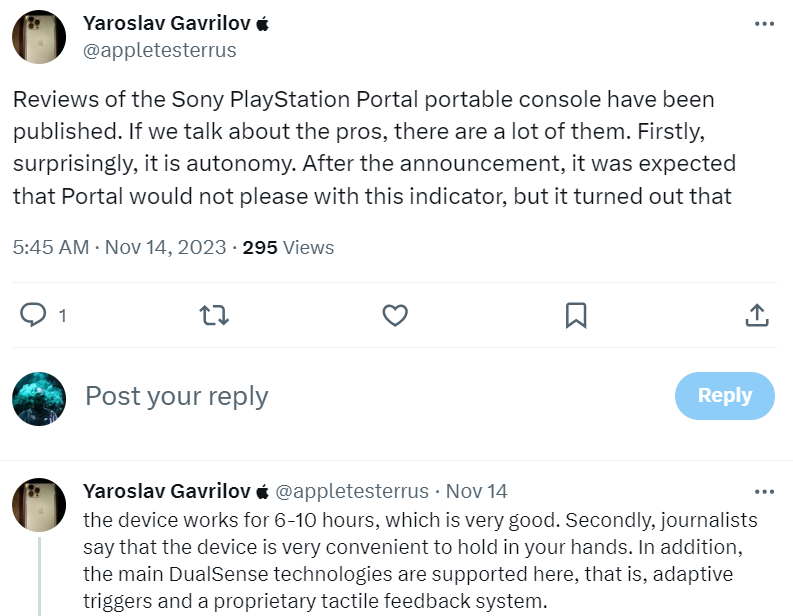New Sony handheld gaming console: destined for success or a repeat of PS Vita’s fate?

- The Sony new ‘PlayStation Portal’ represents a significant leap in handheld gaming.
- The PlayStation Portal features advanced capabilities like seamless PS5 game streaming and DualSense-inspired design.
- Could the new Sony handheld gaming console deliver the best of both worlds?
As we stand on the cusp of a new era in handheld gaming with Sony’s latest offering, it’s a moment to reflect on the journey that brought us here. Sony’s venture into portable gaming has been a tale of ambition, innovation, and learning from the past. It began with the PlayStation Portable (PSP), a device that marked a significant milestone in handheld gaming. Launched in 2004, the PSP was not just a gaming console but a multimedia powerhouse, allowing users to play games, watch movies, and listen to music on the go.
However, the landscape of gaming was changing. With the advent of smartphones and the exponential growth of mobile gaming, the handheld gaming market faced new challenges. Enter the PlayStation Vita, Sony’s answer to a new generation of gamers. Released in 2011, the Vita was a technological marvel with features like a touchscreen, rear touchpad, and the ability to connect with the PlayStation 3 and later the PlayStation 4.
But despite its advanced capabilities, the Vita encountered hurdles and was not the instant smash the PSP had been.
It grappled with high production costs, a complicated game development environment, and fierce competition from more versatile mobile gaming platforms. That translated into lower-than-expected sales and a reduced game library, leading to a premature end to its production in 2019.
This history of highs and lows has been instrumental in shaping Sony’s approach to handheld gaming. Learning from the PSP’s success and the Vita’s challenges, Sony has been poised to create a handheld gaming experience that aligns with today’s gamers’ evolving needs and expectations.
Sony unveils ‘PlayStation Portal’: a new chapter in handheld gaming
In a bold move that could well redefine handheld gaming, Sony has unveiled the ‘PlayStation Portal,’ its latest breakthrough in gaming technology. This innovative handheld device is engineered to transform the way players engage with their favorite PlayStation 5 games. Equipped with an 8-inch display, the PlayStation Portal offers seamless streaming of PS5 titles over wi-fi, utilizing Sony’s cutting-edge Remote Play technology
This groundbreaking device lets PS5 owners enjoy their console games from almost any location with wi-fi access. However, it’s important to note that this streaming function is limited to games available on the user’s PS5 console and does not extend to cloud-based gaming options.

How the new Sony PlayStation Portal operates. (Source – X)
Innovative design meets gaming functionality
The PlayStation Portal’s design pays homage to Sony’s acclaimed DualSense controller, blending a sense of familiarity with innovative elements. Fans of the DualSense controller will immediately connect with the ergonomic design and stylistic cues present in the Portal. It’s as though the DualSense controller has been reimagined and expanded, incorporating a vivid 16:9 touchscreen in its heart.
This device maintains the hallmark features of the DualSense, such as advanced haptic feedback and adaptive triggers, ensuring an engaging and immersive gaming experience.
One potential concern is the possibility of analog stick drift, an issue common in heavily used gaming controllers. Sony’s previous high-end DualSense Edge faced similar challenges, although efforts were made to address this with modular, replaceable stick components. The longevity of the Portal in this regard remains to be seen.
Comparing previous handheld gaming devices with the new Sony PlayStation Portal
When it comes to its physical form, the PlayStation Portal strikes a balance between bulk and manageability. Weighing approximately 530 grams, as reported by The Verge, it finds a middle ground, being heavier than the Nintendo Switch OLED model but lighter than Valve’s Steam Deck. The Portal’s design includes large, ergonomic grips that enhance comfort for extended gaming sessions – despite adding to its weight.
A comparative analysis of the Portal against peers like the Steam Deck and Nintendo Switch sheds light on its performance. Valve’s Steam Deck, for example, offers more power than the Nintendo Switch, but these hardware differences often have minimal impact on the average user’s gaming experience. Over time, factors like gameplay quality and content availability tend to overshadow sheer hardware power.
The ongoing evolution within the Steam Deck’s range, offering various models with core performance similarities but different features, highlights Valve’s commitment to refining the handheld gaming experience based on user feedback and technological progress.
Battery life remains a crucial aspect of any handheld gaming device, and the Nintendo Switch and Steam Deck face challenges in this area. Despite its extensive customization options, the Steam Deck often falls short of sustaining long gaming sessions.
Conversely, the Nintendo Switch struggles with its battery capacity and slower charging speed, a limitation exacerbated by its release just before the adoption of new USB-C standards. These issues impact the overall experience, especially for gamers who rely on their device during long commutes or travel.
Learning from the past: the PlayStation Vita’s legacy
The launch of the PlayStation Portal comes at a pivotal moment for Sony, especially considering the mixed success of its previous handheld device, the PS Vita. While the PSP achieved remarkable global sales, the Vita faced a steep decline, hindered by high production costs, a challenging game development environment, and the shift in focus towards PlayStation 4. Sony attributed the Vita’s underperformance partly to the burgeoning mobile gaming market, a significant competitor during its lifespan.
In contrast, devices like the Nintendo 3DS flourished, benefiting from a strong game library and a user-friendly design that resonated with mobile gamers. The legacy of the Nintendo DS line in handheld gaming also set a high benchmark in the market.
With these historical insights, Sony’s introduction of the PlayStation Portal marks a critical juncture in its handheld gaming strategy. This device, integrating PS5 game playability with a unique design, aims to offer Sony a competitive edge, catering to modern gamers’ desire for flexibility without compromising on a rich gaming experience.









